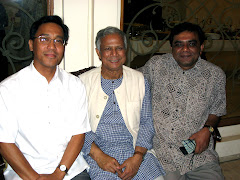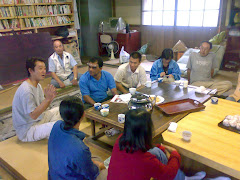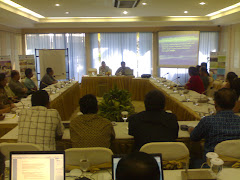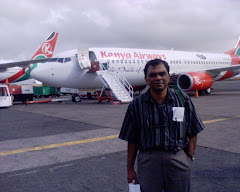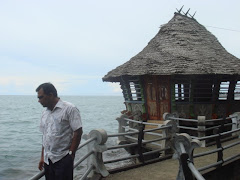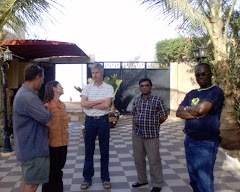Politics of Positive in Community Empowerment
A Story of Appreciative Story Telling in CMDRR Project of Caritas Sibolga
Dr. Shayamal K. Saha
January, 2010
-----------------------------------------------------------------------------------------------
Sisobambowo, a desa (village) of Nias Island of Indonesia frequently exposed with flood; is one the many communities of Caritas Keuskupan Sibolga (CKS) (http://caritas-sibolga.blogspot.com/) covered by its Disaster Risk Reduction Project. In building disaster resilient community, CKS facilitates a community –managed disaster risk reduction (CMDRR) process in which communities are facilitated to form their organization, assess disaster risk, plan, implement and evaluate actions. This goes as continuous cycle. This participatory process of DRR is applied within the concept of problem solving, thus “what is the problem?” commonly becomes a central questions of dialogue and discussions. The facilitator of CKS-CMDRR team began to facilitate the Sisobambowo community since July 2007. Eventually in October 30 2007, a community DRR organization came into being in participation with 21 members in which Kepala Desa and customary leader of the community included. The First community DRR action plan of 2008 was successfully implemented by the community organization (CO). At the beginning of the year 2009 while developing the 2nd yearly action plan the CO of Sisobambowo included one of its activities is to constructed a small bridge in the village ; based on the need expressed by the community members. Economically poor community of Sisobambowo did not see their ability to provide financial resource needed for the construction of the bridge thus expectation to CKS. CKS fell into a dilemma; debate and discussions moved across the organization about whether CKS should provide direct financial support to the community organization to implement such a bridge construction project. CKS management could not make a firm policy decisions and provide resource support to the community for bridge construction. This circumstance generated frustration among the community and their organization. Since February 2009 dialogue between the CKS facilitators and the CO narrowed down to the only issue of Bridge Construction; when CO demanded support to construct bridge and CKS facilitator explained “they are not in a position to provide financial support. The CO began to feel “we cannot perform our role effectively to address community demand - so why should we continue this organization". On the other side CKS team began to feel “it’s so sad that the community and their organization showing negative attitude to them”. Eventually, the movement of
December 2009, as a consultant of CKS-CMDRR project conducted the training on Participatory Monitoring and Evaluation to the CKS-CMDRR team. Without having any other alternative, for conducting field practicum part of this training we decided to go Sisobambowo and work with them. Thought this decision was made, but I could observe gloomy face of staff full of anxiety with uneasy feelings of not receiving any cordial response from the Sisobambowo CO. Anyway, we (all training participants plus me) went Sisobambowo on November 27, 2009. We had meeting, including the Kepala Desa ( Elected head of the village) and Customary Leader altogether 6 CO members kindly came to the meeting. Meeting started and soon the expression of frustration of not being able to construct the bridge became the centre – the discourse of deficit and frustration went for an hour gradually moved to a silence and then feeling of hopeless. At that stage, I made an effort to shift the discussions and dialogue from the failure to success. I asked the CO members to:
• tell a story about “being a member of the CO you felt proud of your organization doing good work for the community”
• tell a story about “you did something as CO members which made you happy”
• Tell a story about “as CO members you did something for the community and community members gave admiration to you?
Silence began to disappear; one after another, the CO members started to tell their experiential stories of success and being appreciated by the community. This positive/success story telling soon discovered that against one failure of bridge building the CO has made following nine successes:
1. Feeling happy because now they have an organization
2. They were able to do mahogany seedling
3. Got many education meetings with Caritas
4. Could organize regular saving money in their organization
5. Became a resource person to others in term of developing community organization, somebody asked & discussed on how to develop an organization (Fasa’aro – vice
1. secretary of CDRO)
6. People in the village come to the CO committee to discuss about their daily life problem
7. They collected some amount of money for earthquake survivors in
8. The CDRO committee got respect from the people due to their position as community organization leaders. (Vina: in communal meeting like party, social celebration, they got simbi - a part of pork/pig body as a symbol of respect in Nias culture, because they are the members of DRR TF).
9. Sisobambowo got a project from health government office from
Telling, sharing and identification of these success stories brought life in the dialogue by generating a sense of appreciation and proud among the members of community organization. Soon they realized that their organization made many success and they should not be frustrated of not being able to do only one - the construction of the bridge- for which they can continue their effort. They could also realize every day we do many good works for our family but it is not possible to meet all demand of all family members at a time. But not being fulfill one demand of a family member should not coz leaving of the guardian of the family. Unanimously all members in the meeting added “we will try to build the bridge but not being able to do so should not stop our other work”. They decided to have next meeting in the first week of December in which they will revise the yearly action plan and move. While coming back from Sisobambowo, on the way I had a small reflection meeting with the staff members of CKS-CMDRR team; I could clearly see the difference in their eyes and face from yesterday. Yesterday they came with feeling of regret and hostility; afraid and anxiety but today with sense of appreciation and enthusiasm. Months of stagnation and frustration transformed into power of moving forward when the TF members were facilitated to share their success stories –that gives life instead of doing postmortem of failure.
I did not know that the staff memebrs of CMDRR project of Caritas Sibolga liked it very much and they would jump on using appreciative story telling so quickly until I went though their annual reflection report 2009 which stated:
“At the end of 2009 in 13 new communities year end reflection meetings were held by using an appreciative approach (guiding questions of appreciative discussion,. Since in the past the process of analysis, awareness, mobilization and community organizing were performed by problem solving approach, in the year end reflection project team deliberately used another new approach (project team adopted this method from Appreciative Inquiry approach). The approach focuses on appreciative discourse that explores the positive side & the potential of community which aims to raise the pride and confidence of the community, so that through internal reflection they do, they find that they have their own power to do self help actions. Many activities came out from community initiatives actually already started to be done by the people since the CMDRR project started in their villages, even before the CO was formed. The experience of CMDRR team to perform appreciative approach in Sisobambowo and 13 communities in the year end appreciative reflection meeting has built the belief among the team members that the appreciative methods is very productive to motivate people to look at the future optimistically and confidently to develop themselves. “Appreciative approach” refer to an effort of facilitating a discourse, telling & sharing stories by exploring the positive & potential side of the community instead of focus on negative/deficit side that tend to raise frustration, hopeless & feeling of not confidence, something the team learned from “Appreciative Inquiry” approach. So CMDRR team will strengthen this approach in facilitating the further CMDRR process.”
2010 the Year of Challenge, Year of Hope: Reflection Notes on Implementation of 2nd Phase CMDRR, Caritas Sibolga, First Year, 2009
This case story put across few lessons for community empowerment facilitators:
· Language and vocabularies is not just a tool for reporting something or sharing ideas but language is the most powerful agent of changing, constructing and reconstructing realities; the way we speak, we form us and our reality.
· Instead of facilitating dialogues and discussions on deficit, community participation and community, management gets better momentum if they are facilitated to be engaged in dialogues and discussions through their success story telling.
· Success story telling not only center interaction processes of community but also generate great sense of appreciation among the community and the community facilitator thus enthusiasm to participate.
· Although it is better to apply 4D cycle[1] of Appreciative Inquiry (AI) without mixing it with Problem Solving approach but if an organization or project is not in position to make radical shift of its approach from PS to AI rapidly then it is also possible to apply ‘appreciative story telling/reflection’ that not only create better effects but also brings lessons and encouragement to the practitioners to learn more and practice AI .
Ample research findings and literature telling ‘starting with problem’ “ makes people / community dependent on outsiders while starting and moving with what the community have is contributory to genuine empowerment. CKS-CMDRR team has made a deliberate attempt of “shifting vocabularies of deficit into vocabularies of hope and strengths” in CMDRR- showing its positive contributions to develop self-reliant community organization. Be it DRR or Livelihood promotion or health & development, if we conceptualize community empowerment is not jut individualistic construction but collective wellbeing then it requires: a shift in focus from building individual capacity to what we can do together; genuine people’s participation and interaction; space for multiplicity - for local creativity and for different ways of learning; a learning culture that encourages community and change agents/ workers to be co-learners and co-constructors, and; working towards opening-up new possibilities. Facilitating success story telling and sharing contributes a lot. However, I would like to request CKS-CMDRR team to remain aware that AI is not just about shifting vocabularies but bringing multiple interaction processes as both unit of analysis and locus of change. I hope gradually the team would learn how to link concepts and approaches of relational/social construction of development and social change in AI cycle application; essential for social transformation.
